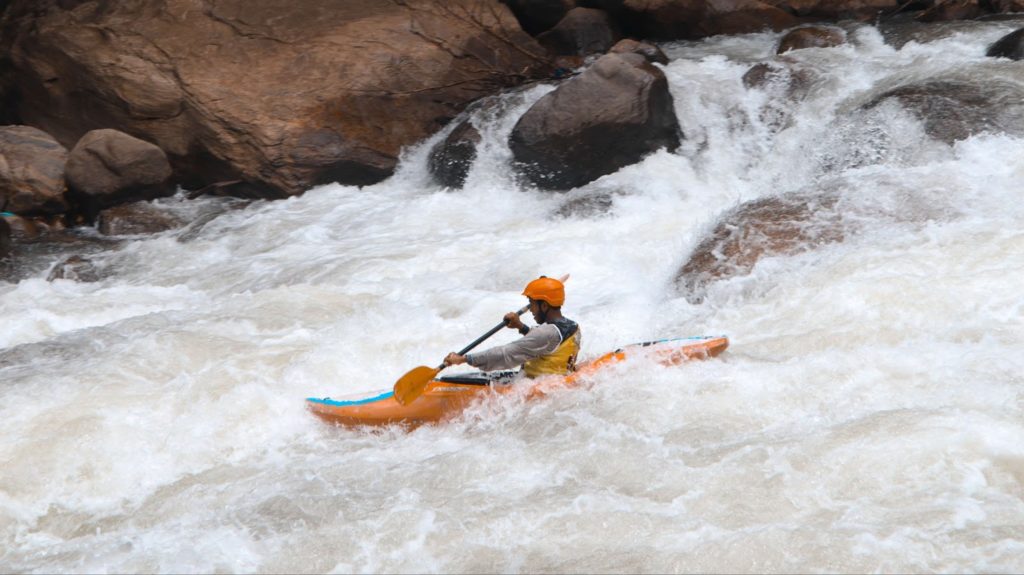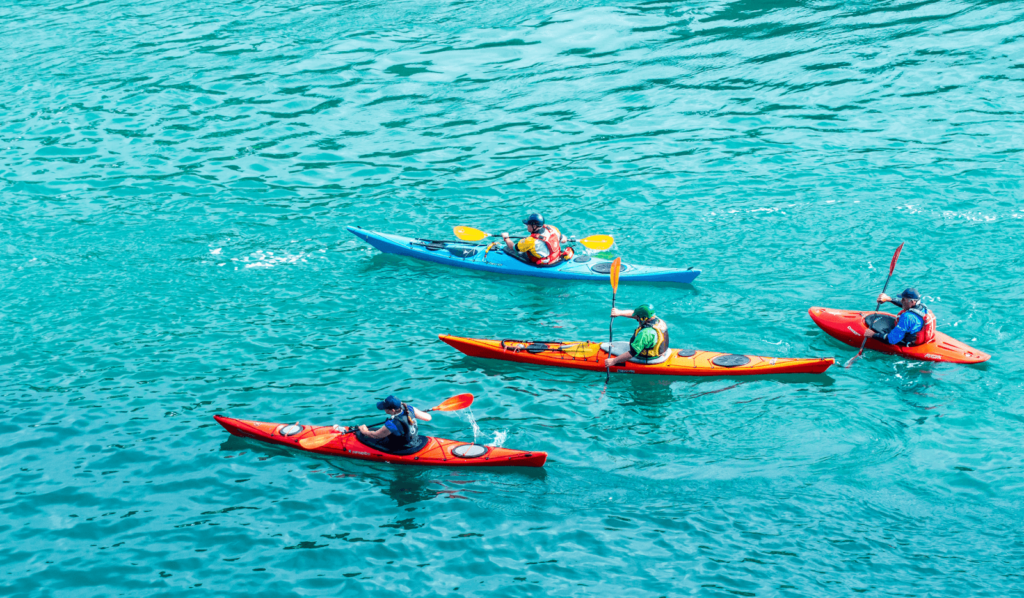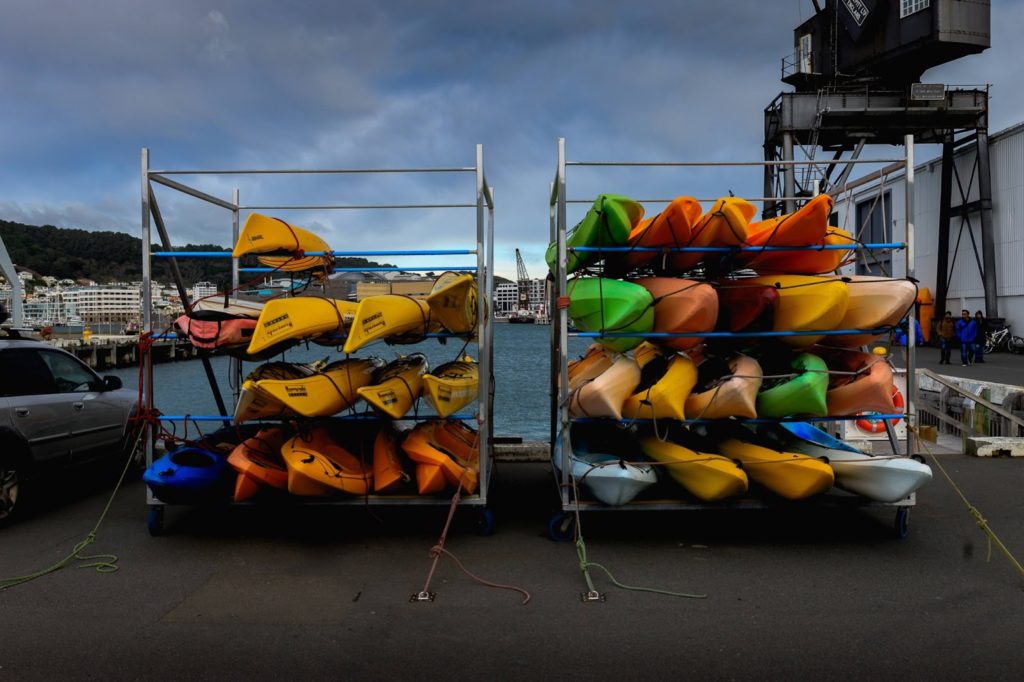With kayaking becoming increasingly popular, it’s no wonder you may consider joining the sport. However, choosing between different brands and types of kayaks to fit your skills or needs best can be challenging. As a beginner, it is important to get the answer to the ‘which kayaks are the most stable question’ and understand why.
Types of Kayaks

There are several kayak types that each have different purposes for different levels of kayakers. As such, you must learn the five most common types of kayaks you can purchase and the level of stability that they offer.
1. Sit-On-Top Kayaks
A sit-on-top kayak is a watercraft with no enclosed or designated cockpit for the kayaker to sit on during the session. These kayaks tend to be much broader, giving them good primary stability, which helps to reduce the impact of excessive movement, whether by the kayaker or waves.
Example: One Person Riber Kayak
The One-Person Riber kayak has a length of 286 cm and a width of 77 cm and can carry around 180 kg. It is excellent for beginners and provides satisfactory stability when on the water because of its large size and the hull’s curvature.
It is most suitable for flat water and includes a comfortable backrest to ensure you won’t have to move around too much to get into a comfy position. The rocker of the hull also contributes to the kayak’s stability at sea and amongst moderately rough waves.
2. Whitewater Kayaks

People who use whitewater kayaks are often thrill-seekers who want to be able to ride the wild waves of active rivers. Whitewater kayaks are lightweight and tend to be smaller than other kayaks. Being smaller makes it easier for you to control and direct the kayak to move against water.
Whitewater kayaks tend to have a lot of natural stability in rough waters; however, not so much in flat water. They also tend to have rounded hulls that offer a lot of secondary stability and thus help prevent you from capsizing if you end up leaning over one edge too quickly or excessively.
Example: Liquidlogic Remix 47
The Liquidlogic Remix 47 is a sit-inside whitewater kayak around 221 cm in length and 21 cm in width. It can carry a 50 kg load, and the kayak material uses polyethylene, ensuring good flexibility and moisture barrier properties.
Additionally, the Liquidlogic Remix 47 is a reasonable option for beginners and intermediate-level kayakers due to its stability in whitewater. It also comes with an adjustable backrest and seating.
3. Touring (or Sea) Kayak

Touring kayaks are most suitable for people who want to kayak for long distances across open water. These kayaks have a longer length, and some brands can accommodate up to three paddlers, one in the middle and two on either side.
Touring kayaks often have v-shaped hulls, enabling you to maintain higher speeds with minimal drag when going in a straight line. The hull design of touring kayaks also offers a lot of secondary stability.
Example: Navarro 130
The Navarro 130 is a one-person touring (or sea) kayak that is 401 cm in length and can handle a maximum capacity of 136 kg. It is around 95 cm in width, and you can easily add a zip-on cover to protect the kayak, depending on weather conditions.
The cozy backseat of the Navarro 130 also helps to prevent needing to move around at rest, ensuring its stability. The backrest is also breathable and offers a thick, padded cushion for maximum comfort. It is an excellent option for flat and rougher water.
4. Canoe / Kayak Hybrid
The canoe/kayak hybrids may look more like a canoe at first glance; however, they paddle more like a kayak. Many people use these kayaks for flat water, and they tend to have more space than a regular kayak.

Canoe/kayak hybrids have good primary stability since you can stand in the center without worrying too much about capsizing. These kayaks also have sturdy and comfortable seats that stabilize you while you are kayaking or resting.
Example: Outlaw 11.5 Perception Kayak
Many describe the Outlaw 11.5 Perception kayak as a highly functional canoe/kayak hybrid. The kayak is around 89 cm in width and 351 cm in length, giving enough room for you to use the kayak recreationally for activities like fishing.
It is a single-person kayak with a capacity of 193 kg and an adjustable seat for comfort over long rides. The Outlaw 11.5 Perception kayak is more stable in flat water due to the long length and hull.
Factors That Contribute to Kayak Stability Levels

When getting started with kayaking as a sport, you’ll need to learn which properties kayaks possess that influence stability.
Kayak Width
Kayaks that are wider tend to be more stable since they offer more surface area on which the user can balance. It is easier for a kayaker with less experience to balance on a kayak with a broader base, thus preventing them from tipping over and capsizing.
Width-wise, sit-on-top and sit-inside kayaks are around 69 to 91 cm in width, depending on the kayak’s brand and purpose. When it comes to whitewater kayaks, they’re often much smaller at around 55 to 71 cm in width.

Whitewater kayaks are less broad since it is easier to navigate a smaller kayak on top of raging rivers. It also makes it easier for the kayaks to resurface after going underwater and prevents the kayak from having too much surface area to snag on tight corners in whitewater.
Furthermore, touring kayaks range from 25 to 66 cm in width, a good range for making longer journeys. Lastly, hybrid kayaks tend to sit at over 95 cm in width, making them the most stable according to size.
Primary Stability
Primary stability on a kayak refers to the kayak’s stability at rest. It measures how easily a kayaker can move on the kayak without accentuating any movements and causing it to shake.
Kayaks with good primary stability are best for flat water, including sit-inside, sit-on-top, and canoe/kayak hybrids. However, sit-inside kayaks have better primary stability than sit-on-top kayaks since the sides help to stabilize the user when they move.

Canoe/kayak hybrids have better primary stability than sit-inside and sit-on-top kayaks since they tend to have a much broader and much flatter hull design. A flat design provides a lot of contact with the water surface to increase stability at rest.
Secondary Stability
The secondary stability of a kayak refers to its ability to correct itself after the user leans on either side. It also portrays the kayak’s resilience when it rocks through the strength of moderate or more powerful waves.
A whitewater kayak is a prime example of a watercraft with excellent secondary stability. Whitewater kayaks need to withstand rough waves and right themselves if the kayak sways from side to side or turns over.
In continuation, touring kayaks also have good secondary stability since they must resist harsh sea waves across long distances. Both touring and whitewater kayaks often have less flat hull designs, so it is easier for users to lean into or against waves for better stability.
Conclusion
The canoe/kayak hybrid is the most stable kayak for flat water. However, whitewater kayaks are the most stable for rough waters. If you’re a beginner, consider looking into either option for your first excursion into the water to maintain stability.
Frequently Asked Questions
What Is the Most Stable Hull Design for a Kayak?
Kayaks with flat hull designs provide the most stability for flat water. A flat hull increases the contact area between the watercraft and the water, making it much easier for kayakers to keep the boat steady and stable. For whitewater, a round hull design is better to ensure secondary stability.
How Can I Make My Kayak More Stable?
You can focus on the weight distribution to stabilize your kayak. When weight is concentrated more on either side of the boat, it may not tip, but it will lead to less stability. To prevent unequal weight distribution, try to sit directly in the vessel’s middle section and refrain from standing abruptly or sprawling out in the kayak.
Are Heavier Kayaks More Stable?
If the kayak is heavier due to being wider, it is more stable. Wider kayaks have more surface area to balance against the waves. Similarly, if the kayak is heavier due to being longer, it can also provide more stability since the length can offer resistance against the kayaker tipping from side to side.
